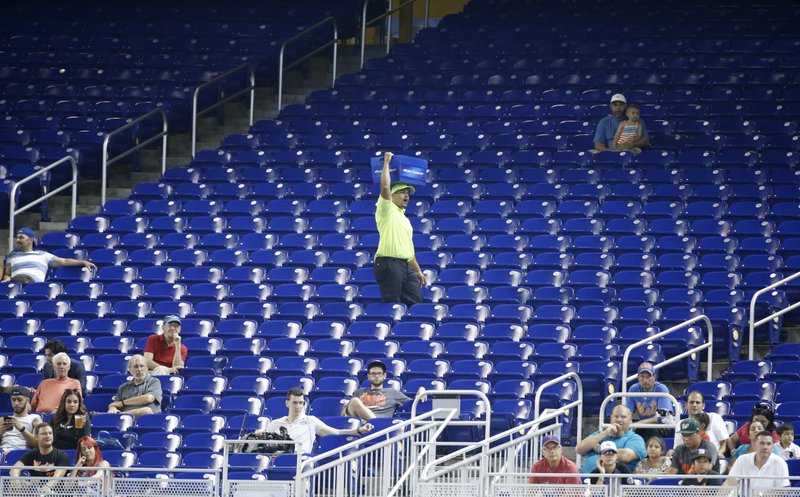MIAMI -- A Miami Marlins fan walks into a bar, and this is no joke: He wants to watch his team play, but all 10 televisions are tuned to other games in other time zones.
The bar, located near Marlins Park, where the Major League Baseball All-Star Game is being held Tuesday, broadcasts the lack of allegiance for the home team loud and clear.
It's not something likely to happen in any other big-league city, except possibly Tampa Bay, the other Florida market with a major-league team.
Like the Marlins, the Rays are last in their league in attendance and battling the kind of chronic fan apathy that has plagued both franchises since they were founded in the 1990s.
The Rays have finished last in the majors in attendance every year since 2011, when they were next to last. The Marlins have finished last in the NL 11 of the past 12 seasons.
"I don't know what the disconnect is," said NL All-Star manager Joe Maddon, who spent nine seasons as Tampa Bay's manager. "Spring training has been here for 100 years. You would think this would be a strong area for baseball."
Instead, it's a strong area for foul-ball collectors, because they face little competition.
Many spectators who do show up care more about the visitors -- even if that means booing them. Orioles starter Ubaldo Jimenez heard jeers from Baltimore fans recently as he left the mound after a poor performance at Tampa Bay.
Marlins supporters were badly outnumbered in June against the visiting Cubs and Mets.
"It's not a great situation," said Miami manager Don Mattingly, accustomed to a more favorable home atmosphere when he played for the Yankees. "It would be nice to have a packed house with Marlins fans, so Cub fans or Met fans can't get tickets. But that's not the case. What are you going to do?"
Both Florida teams tried changing their name; that didn't help. It turned out calling them the Tampa Bay Devil Rays and Florida Marlins wasn't the issue.
So what is? Theories might outnumber empty seats.
"There are a bunch of problems," said Rays first baseman Logan Morrison, who also played for the Marlins.
One issue is the transient nature of the state, which makes it different from markets where fan support goes back generations.
"A lot of people who live in Florida aren't from Florida," Morrison said. "The organizations are relatively new, so you don't have fans with deep roots. A lot of people who go to games in the Florida markets are fans of other teams."
For both the Marlins and Rays, modest payrolls have made it tough to keep popular -- and expensive -- players. Constant roster turnover has alienated fans, especially in Miami, where unpopular owner Jeffrey Loria's team is for sale.
The All-Star Game will showcase the Marlins' 5-year-old ballpark, which received rave reviews but hasn't helped attendance. The Rays, by contrast, play in 27-year-old Tropicana Field, widely regarded among the worst facilities in professional sports.
Neither ballpark is centrally located in its region, making for long drives at rush hour for many potential spectators.
"There are a lot of Marlins fans," said Marlins executive Jeff Conine, a former All-Star Game MVP. "I get recognized wherever I go. People like the Marlins. They just don't come to games."
Most South Floridians don't watch on TV, either. The Marlins ranked 26th in the majors in ratings last season; the Rays ranked 14th.
When expansion brought teams to Florida, Major League Baseball anticipated success in a state with a rich spring training tradition. But many of the fans who attend those games are gone in the summer.
The Rays' best hope for a turnaround is a new ballpark in Tampa, across the bay from their current home in St. Petersburg. A vote last year allowed the Rays to start looking at possible sites in Tampa, but the process of relocation will likely be lengthy.
In Miami, antipathy toward Loria keeps many fans away, and the anticipated sale of the team could provide a reboot. But there's no guarantee new ownership will succeed where three previous Marlins owners failed.
Lack of competitiveness is often pointed to as the reason for the lack of fan loyalty.
And it's that Florida's teams have reached the playoffs six times in their 43 combined seasons. The Marlins haven't been to the postseason since 2003, the longest current drought in the NL.
But the Marlins have had their moments, actually two moments, and they made them count.
They won world championships in 1997 and 2003, both times getting to the world series as a wild-card team, giving them two world championships in their first 11 seasons of existence.
The Rays, meanwhile, made the World Series in 2008 (losing to Philadelphia) and have two division titles, both under Maddon, who will be managing the NL All-Star team on Tuesday night.
"I don't think it's a market we should give up on just yet," said South Florida native Mike Lowell, who played for the Marlins' 2003 World Series champions. "You need teams to make another playoff run. A little has to be thrown on the fans. You asked for a stadium, and got it. Fans are not coming out as projected or hoped."
Sports on 07/10/2017

